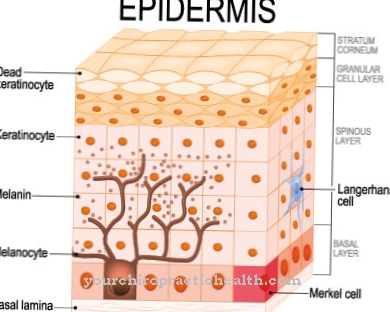Patients with a Metamorphopsia suffer from subjectively perceived visual disturbances. The cause of this phenomenon can usually be found in the psychological or neurogenic area, whereby the visual disturbance can take different forms from distortions to changes in proportion. Treatment depends on the cause.
What is metamorphopsia?

© GraphicsRF - stock.adobe.com
From an evolutionary point of view, the sense of sight is one of the most important human sensory systems. Compared to other living beings, the human visual system has ensured a survival advantage. Since the dawn of mankind, humans have relied most on perception through the eyes to assess the dangers and opportunities in their environment.
Humans are therefore considered to be eye-controlled living beings. Since the sensory system, like all other sensory systems, corresponds to a highly complex, neuronally controlled system, disorders of the visual system occur relatively frequently. Metamorphopsia is a group of visual disorders. This is a subjectively perceived visual disturbance that is not necessarily due to physical causes.
Metamorphopsia can take different forms. Examples are micropsia, macropsia, dysmorphopsia or teleopsia and pelopsia. Other forms are achromatopsia, chromatopsia, akineteopsia and the corona phenomenon. In any case, those affected report a distorted or otherwise changed perception of their environment. In addition to the simple metamorphopsia, there is a complicated metamorphopsia that shows psychological effects.
causes
Physical and psychological phenomena can be considered as causes of a subjectively perceived visual impairment. If there is physical pathogenesis, the affected person has either an eye disease or a neurogenic disease. With a neurogenic cause, metamorphopsia occurs mainly after damage to the optic nerve or the visual pathways.
These phenomena can, for example, be preceded by strokes or cerebral hemorrhages as part of a traumatic brain injury. Inflammatory changes within the neuronal visual centers are also possible neurogenic factors. Psychological causes can exist, for example, as part of a derealization.
Derealization is a condition in which patients perceive their environment as distant, artificial or fake. For example, proportions can be perceived as incorrect. In most cases, derealizations are accompanied by depersonalization. Such a condition can arise, for example, when people go through a life-threatening situation.
Through derealization and depersonalization, the patient withdraws from the world or no longer perceives the world as real in order to protect himself from life-threatening or otherwise traumatizing environmental events.
Symptoms, ailments & signs
Metamorphopsia is characterized by various symptoms in individual cases. The condition of patients depends on the shape of the metamorphopsia. With micropsia, the patient perceives their surroundings or individual details from them, for example in miniature. In macropsia he sees details or the entire environment in magnification.
Patients with dysmorphopsia, on the other hand, experience their surroundings as misshapen and distorted. With teleopsia, the environment moves far away and with pelopsia objects move unnaturally close. Patients with achromatopsia do not perceive colors. Chromatopsia changes the color perception of individual objects or, as with cyanopsia, the overall environment.
Patients with akineteopsia no longer perceive moving objects at all and with the corona phenomenon there is a colored frame around individual objects in the environment. Especially with an overall distortion of visual perception, psychological complaints often arise, such as fear or a depressive mood. If the perception phenomenon is based on a psychological cause, accompanying symptoms are usually abnormal emotional impulses.
Diagnosis & course of disease
The characterization of every visual disorder includes a differential diagnostic clarification of the problem. The doctor receives the first indications of a metamorphopsia in the anamnesis. In the context of diagnostics, it limits the cause to the neurological, ocular tissue or psychological area.
With this aim, in addition to an ophthalmological and neurological assessment, a psychiatric assessment of the patient is carried out. In ophthalmology, the Amsler test is available for the purpose of diagnosing visual impairment. The prognosis for patients varies depending on the cause. Neurogenic visual disturbances sometimes have the worst healing prospects.
Complications
In most cases, metamorphopsia leads to both psychological and physical limitations in the patient. Those affected primarily suffer from visual disturbances and visual problems, which, however, occur due to psychological causes. Visual disturbances can have a very negative effect on the quality of life of the person affected and reduce it.
Everyday life is also made significantly more difficult by these disturbances, so that various activities are impaired. It is not uncommon for the visual problems to lead to dizziness, nausea and impaired concentration and coordination. Metamorphopsia can lead to developmental disorders, especially in children.
Due to the illness, the outside world appears either enlarged or reduced to the patient. This can also lead to dangerous situations if the patient does not recognize or cannot assess certain dangers. Furthermore, metamorphopsia usually occurs together with depression and anxiety. People may also have epileptic seizures.
A direct treatment of metamorphopsia is not possible, the treatment depends heavily on the psychological cause. It cannot be generally predicted whether this will lead to a positive course of the disease. As a rule, however, the life expectancy of the patient is not reduced by the metamorphopsia.
When should you go to the doctor?
Metamorphopsia leads to impaired vision. As soon as there are irregularities in the eyesight or objects in the field of vision are perceived differently than by other people present, a doctor should be consulted. Although metamorphopsia is not an organic irregularity or visual disorder, a dysfunction of the eye must be examined and ruled out by medical tests. If the existing symptoms increase in scope and intensity, a doctor is required. Persistent disruptions are also a concern and should be addressed. If the person concerned notices an increased risk of accidents in everyday life due to impaired vision, caution is advised.
The handling of everyday obligations should be restructured and optimized so that there are no further problems, accidents or disruptions. If the person concerned is suffering from anxiety or panic due to decreased vision, he should see a doctor. In the case of decreased well-being, headaches, digestive disorders or irritability, there is an irregularity that should be treated. Often the symptoms are psychosomatic disorders that also occur due to the stress and should be discussed with a doctor. Mood swings, behavioral problems, or withdrawal from social life are other signs that should lead to consulting a doctor.
Treatment & Therapy
Therapy for patients with metamorphopsia depends on the underlying disease. Different therapeutic approaches are used for psychological causes such as derealization. The main aim of drug therapy is to relieve the patient of their fear of distorted perceptions. A cognitive-dynamic approach is often used in psychotherapeutic therapy.
In doing so, patients learn to reevaluate their visual perceptions and to no longer perceive them as unreal or distorted. The subjective visual impairment occurs in association with physical causes, especially in the context of an Alice in Wonderland syndrome. This syndrome is often characterized by migraine attacks or epileptic fits. In this context, the patient's metamorphopsia improves if the underlying disease improves.
Those affected are usually treated conservatively with medication in order to delay the seizures. If scarring around the eyes is related to the visual impairment, the scars will be removed as much as possible with a laser. Metamorphopsia due to right-sided posterior brain damage can hardly be treated. Nerve tissue in the brain is highly specialized. The brain can therefore usually not fully recover from damage.
You can find your medication here
➔ Medicines for visual disturbances and eye complaintsOutlook & forecast
The prognosis of metamorphopsia is based on the underlying primary disease. A distinction must be made here whether it is a physical or psychological disorder. With psychotherapeutic treatment and lifestyle changes, patients with mental problems can be free of symptoms. There is also a possibility that the transmitter has been damaged. This is usually irreversible, so that the symptoms are often not alleviated for physical causes. Neurogenic irregularities can lead to the development of a life-threatening condition.
If the disease progresses unfavorably, the patient is at risk of a stroke or sudden bleeding in the brain area. This increases the risk of premature death and an intensive care emergency arises. In the case of a mental disorder, it must be clarified how extensive it is. Some disorders can be cured. Usually medication is given to alleviate existing symptoms. If cognitive changes take place at the same time, healing can be achieved. However, the process is lengthy and the success is linked to the cooperation of the patient. If there are severe mental disorders, there are usually no good prospects for recovery. Often the course of the disease is chronic or the disease is indivisible.
prevention
Mentally conditioned metamorphopsia can be prevented by strengthening the psychological constitution of the patient. An improvement in the constitution can be achieved, for example, with timely psychotherapy in stressful situations.
Aftercare
Metamorphopsia can lead to various complications and complaints if it is not treated or not treated properly. Therefore, the person affected with this disease should consult a doctor at the first symptoms and complaints in order to prevent further worsening of the symptoms. As a rule, this disease cannot heal itself, so a visit to a doctor is always necessary.
In most cases, the person affected will suffer from severe visual problems during metamorphopsia. The size of different objects can no longer be displayed correctly, so that there are great difficulties and complaints in everyday life. The perception of colors can also be severely disturbed.
Many patients develop depression or strong psychological moods as a result of these complaints, which can also lead to depression or bullying in children. It is not uncommon for those affected to suffer from a loss of appetite or severe weight loss as a result. As a rule, the disease can be treated well, although the further course depends heavily on the time of diagnosis. The life expectancy of the person affected is usually not reduced by the metamorphopsia.
You can do that yourself
The possibilities of self-help and self-treatment in metamorphopsia are relatively limited.
As a rule, those affected always have to rely on medical treatment to limit the symptoms. A psychological or therapeutic treatment of the disease is particularly suitable. In many cases, this can be supported and accompanied by discussions with friends or your own partner. Conversations with other people affected by metamorphopsia can also have a positive effect on the course of the disease. As patients frequently suffer from migraines and epileptic seizures, no dangerous or strenuous activities should be carried out in everyday life. In the event of an epileptic fit, call an emergency doctor immediately. If the patient is responsive, he should be reassured. In the event of loss of consciousness, regular breathing and a stable side position must be ensured.
Metamorphopsia can usually be avoided if the person affected recognizes psychological complaints or depression at an early stage and has them treated. Visits to a doctor are not always necessary. Discussions with parents or other close people often help.



.jpg)




















.jpg)



